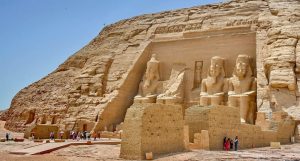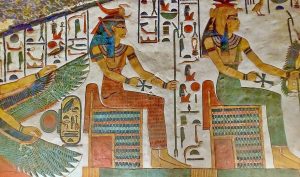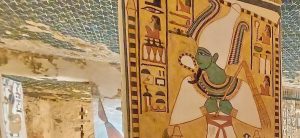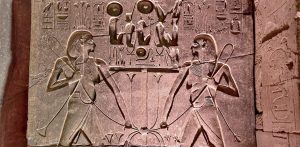Who is King Thutmose III?
He is the 18th dynasty’s sixth pharaoh. Thutmose II, his father, married Hatshepsut, his sister, but they had no kids. He married another commoner and had Thutmose III as a result of their marriage. Tuthmose II died in 1479 BC, leaving the kingdom to his six-year-old son, Thutmose III. His aunt and stepmother appointed themselves as guardians of the young king’s throne, and after two years, she proclaimed herself queen to the throne and ruled for twenty years, then vanished, and Thutmose III ascended the throne in 1455 BC. Thutmose III is considered Egypt’s greatest ruler and one of history’s most powerful emperors, as he established a modern Egyptian Empire. It lasted until Ramses XI’s reign in around 1070 BC. Thutmose III was a military genius with supernatural personality qualities. He trained on the Luxor battlefields, and these exercises gave him valuable military experience at a period when Hatshepsut was in charge of the army and supplied it with cavalry and chariots. He mastered several things throughout his rule. Archery and arrows were manufactured by the Egyptians perfectly at his time. Thutmose III launched sixteen military campaigns against Asia, establishing Egypt’s power in Syria and Palestine, as well as in Nubia in the south.
King Thutmose III’s campaigns and battles
These are the conflicts and military campaigns fought by Ancient Egyptian King Tuthmosis III after he ascended to the throne following his aunt Hatshepsut’s death.
The Battle of Megiddo and the first campaign: The fight is engraved on one of the walls of the Karnak temple, and it is the first war recorded conflict in the history of the ancient world. The leader of the army clerk was given to this tremendous responsibility, and copies of these records were stored in the temple of the deity Amun-Ra at Thebes, and only the writings reached us, with portions inscribed on the walls of the Karnak temple by Thutmose III.
The army’s route to Megiddo was as follows: On April 19, 1479 BC, Thutmose’s army marched from the Citadel of Sila (now the Qantara), through the desert that ran along Palestine’s eastern and southern boundaries. In the morning, he marched with his army to Yaham, which is now Yama, which is eighty miles from Gaza. On the 21st day of that same year, the king gave instructions to prepare for combat and headed off in his golden chariot. The left-wing of His Majesty’s army was stationed on a hill south of Qena, while the right wing was stationed in a camp northwest of (Megiddo), and when the enemy saw Thutmose’s army and might, they fled to (Megiddo) with terrified faces. They had thrown the ground like fish in the ropes of a net, leaving their horses and chariots, and Thutmose’s army took all the reasons for joy, offering praise to God (Amon) for the victory he gave his son on this day, and the site of Megiddo was one of the greatest battles in the history of wars because it is a historical document.
King Tuthmose III is the greatest warrior

To the world, Thutmose III was a war commander whose talents were not limited to being an army general, and this was not only because he was a brave and skilled leader, but also because he had the courage to take risks, knowing the consequences ahead of time, to reach his goal quickly, and demonstrated his war skill in the face of the enemy, and the great wealth that Thutmose III accumulated from this country.
The Campaigns
The word of Egypt’s triumph reached Assyria, prompting the ruler of that nation to send presents to King Thutmose, who recorded them in his war records as proof of his authority and glory. And all of King Thutmose III’s subsequent campaigns were to inspect the conditions of the countries he had conquered and the loyalty of the princes to him, as well as to bring a large amount of wood that the Egyptian countries lacked, and the 8th campaign, which he carried out in the 32nd year, was one of his greatest campaigns. Where he only achieved what he had hoped for, namely, reaching the Euphrates River and subjugating all of the surrounding lands, and King Thutmose III documented his success in this war in the painting (Jabal Barkal).
King Thutmose III Achievements:
Many temples were erected at Thebes by King Tuthmose III, including two temples near the Temple of Hatshepsut in Deir el-Bahari. He also finished the temple (Habu) that Hatshepsut had begun, and he built the temple of the god Ptah in Memphis, which contains three rooms, the first for Ptah, the second for Hathor, the goddess of Thebes, and the third for the goddess Semekht, the god Ptah’s wife, where she is represented by a statue with a lioness’ head on top of the sun disc. He erected seven obelisks, most of which can be seen throughout the world’s cities, including one in London and another in New York.
Tuthmosis III’s death (his tomb):
After fifty-four years of rule, Tuthmosis III died at the age of 82. His tomb is No. 34 in the Valley of the Kings, where he is one of the Valley of the Kings’ first kings to build tombs for himself. Tuthmosis III’s tomb, designated by the scientific symbol Kv34, is a carved-in-rock mausoleum distinguished for the beauty of its coordination and correctness of design and implementation. Stairs lead to a lofty room and stairs go to a huge lower room that houses the sarcophagus. Drawings of ancient Egyptian religious monuments and writings inscribed in hieroglyphs from the Book of the Dead adorn the walls of the chambers.






